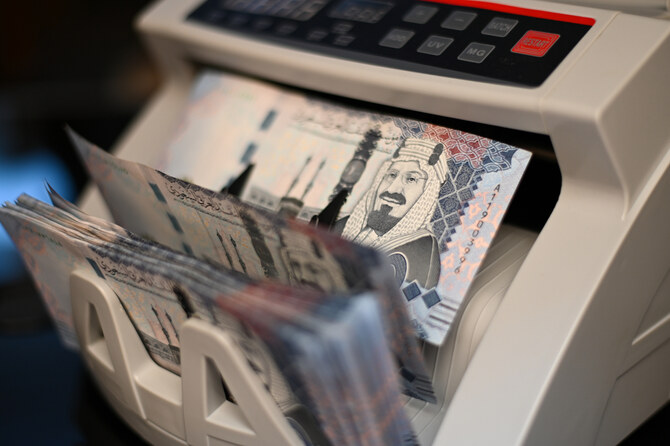RIYADH: Banks operating in Saudi Arabia and the UAE are expected to post strong credit growth in 2025, driven by high crude prices and the expansion of the non-oil economy, according to an analysis.
In its latest report, Fitch Ratings projected that banks in the Kingdom will witness a financing growth of around 12 percent in 2025, about twice the average of the Gulf Cooperation Council region.
The US-based agency added that corporates will account for almost 65 percent to 70 percent of new financing among Saudi banks in 2025.
The analysis echoes similar views to those put forward by Moody’s in November, which predicted that Saudi Arabia’s Vision 2030 initiative, aimed at diversifying the Kingdom’s economy, could accelerate the growth of the banking sector in the country.

Shutterstock
In its report, Fitch Ratings said: “The operating environment for banks in the Kingdom is underpinned by high oil prices and government spending, which support the country’s giga-projects and the Vision 2030 strategy, resulting in solid non-oil gross domestic product growth.”
It added: “Fitch Ratings forecasts real non-oil GDP growth to average a still strong 4.5 percent over 2024–2025, compared to 5 percent over 2022–2023. We expect the sector’s financial metrics to remain strong in 2025.”
The report said that the gradual execution of giga-projects should continue to underpin banks’ interest in this segment, although the current share of giga-project-related financing is minor for most rated banks.
However, the credit rating agency warned that the net foreign assets of banks in the Kingdom could continue to be negative in 2025 due to high-cost domestic term deposits and increased demand for foreign currencies.
Regional outlook
According to the analysis, banks in the Middle East region are expected to maintain sound profitability, solid liquidity, and adequate capital buffers for their risk profiles in 2025, while asset quality should remain stable.
In November, a report released by S&P Global said that banks in the GCC are expected to maintain strong asset quality, profitability, and ample liquidity through 2025 thanks to solid capitalization and well-managed balance sheets.
S&P Global, however, warned that heightened geopolitical tensions and a sharp drop in oil prices could negatively affect the creditworthiness of financial institutions in the region.

Shutterstock
UAE
Fitch said that banks in the UAE will enjoy favorable business and operating conditions in 2025 thanks to high oil prices and increased economic activities.
The analysis added that banks in the Emirates will achieve a loan growth of around 9 percent in 2025, a figure well above the GCC average but slightly below its Arab neighbor, Saudi Arabia.
“We expect UAE banks’ funding and liquidity to remain strong and deposits will continue growing in line with lending. Liquidity will continue to be supported by large government deposits, driven by the sovereign’s solid net external assets position, still-strong fiscal metrics and recurring hydrocarbon revenues,” added Fitch.
Egypt
The report highlighted the growth of the banking sector in Egypt and said that general business and operating conditions for financial institutions in the country are expected to improve next year.
According to Fitch, falling inflation, improved investor confidence, and healthy foreign currency liquidity conditions are some of the major factors that could strengthen the banking sector in Egypt in 2025.

Shutterstock
Bahrain
In Bahrain, credit growth among banks is expected to be reasonable, albeit still modest, compared to GCC peers, at around 4.5 percent in 2025.
“Fitch expects the business environment for banks in Bahrain to remain adequate, underpinned by some operating condition improvements. Lower lending rates should ease pressures on the sector’s corporate loan books, in particular real estate and contracting,” said the report.
The credit rating agency predicted stable asset quality metrics for Bahraini banks in 2025, with lower rates providing relief to corporate borrowers and households and the sector profitability to remain sound.
Kuwait
According to the report, the banking sector’s credit growth in Kuwait is expected to hover between 5 percent and 6 percent in 2025, albeit hindered by still-high interest rates and only moderate real non-oil GDP growth.
The analysis revealed that liquidity among Kuwaiti banks will remain strong next year due to large and stable deposits from government-related entities and gains from high oil prices.
Oman
Fitch revealed that Oman’s Vision 2040 program aimed at diversifying the country’s economy could open more opportunities for banks in the future.
“Oman’s Vision 2040 will provide growth opportunities for banks and ensure a healthy lending pipeline in key sectors of the economy, as well as reduce banks’ reliance on government spending in the long run. However, the absence of a deep capital market limits access for corporates to funding sources other than the country’s domestic banks,” said the study.
The analysis added that liquidity among Omani banks will continue to be supported by stable government and government-related entity deposits, while high oil prices are expected to support the growth in customer deposits.
Qatar
In Qatar, the general business and operating environment for banks are projected to improve in 2025.
The report revealed that the credit growth among Qatari banks could pick up to 5.5 percent next year but will remain below that of Saudi Arabia and the UAE due to their particularly strong operating conditions.
Jordan
In Jordan, the market conditions of banks are expected to remain challenging next year, while the sector will witness a lending growth of 3.5 percent.
“The operating environment for banks in Jordan remains challenging due to below-potential and structurally weak real GDP growth, and high unemployment and geopolitical risks, which negatively affect tourism and exports,” concluded Fitch.






















